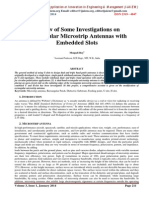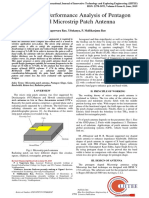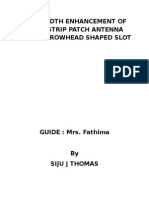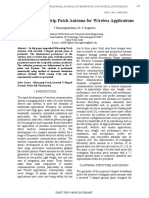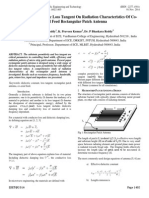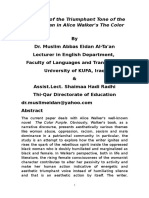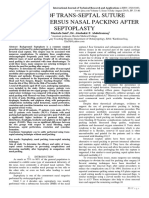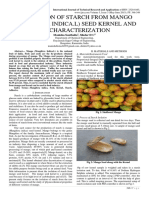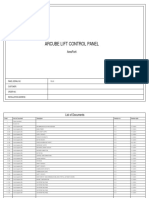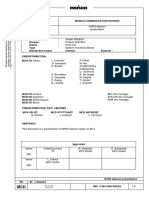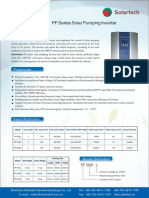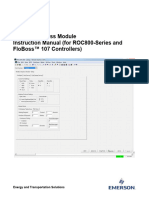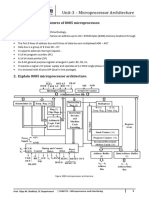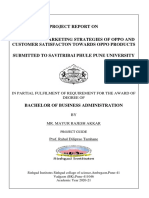Performance Analysis of Microstrip Patch Antenna Using Coaxial Probe Feed Technique
Performance Analysis of Microstrip Patch Antenna Using Coaxial Probe Feed Technique
Copyright:
Available Formats
Performance Analysis of Microstrip Patch Antenna Using Coaxial Probe Feed Technique
Performance Analysis of Microstrip Patch Antenna Using Coaxial Probe Feed Technique
Original Title
Copyright
Available Formats
Share this document
Did you find this document useful?
Is this content inappropriate?
Copyright:
Available Formats
Performance Analysis of Microstrip Patch Antenna Using Coaxial Probe Feed Technique
Performance Analysis of Microstrip Patch Antenna Using Coaxial Probe Feed Technique
Copyright:
Available Formats
International Journal of Technical Research and Applications e-ISSN: 2320-8163,
www.ijtra.com Volume 3, Issue 3 (May-June 2015), PP. 365-367
PERFORMANCE ANALYSIS OF MICROSTRIP
PATCH ANTENNA USING COAXIAL PROBE
FEED TECHNIQUE
Mr. Murthi Mahadeva Naik G.1, Dr. Naveen Kumar S.K.2, Bhavya B.P.3
Department of Electronics & Communication Engineering,
1,3
Malnad College of Engineering, Hassan.
2
Mangalore University, Magalore.
Murthyishu1@gmail.com, nave12@gmail.com, bhavyabp123@gmail.com
Abstract Microstrip patch antennas are the most common form
of printed antennas. They became very popular due to their low
profile geometry, light weight and low cost. A Rectangular
Microstrip Patch Antenna with probe feed and substrate used is
Arlon AD260 has the relative permittivity of which is 2.6 is
designed and simulated using high frequency structure simulator
(HFSS). All the Parameters of this microsrip patch Antenna such
as bandwidth, S - parameter, Reflection loss and VSWR has been
found and plotted. The main objective of this work is to consider
the reactive loading effect on the patch and its effect towards the
improvement of the antenna characteristics, particularly the
radiation characteristics in principle plane (E and H) is
examined. As per theoretical approach reactive loading creates
either capacitive loading or inductive loading. Due to this effect
the antenna performance may be degraded or enhanced in terms
of efficiency, isolation, gain, impedance matching etc. The results
of this designed antenna are compared with the existing Micro
strip antenna.
Index TermsMicro strip Patch Antenna, Coaxial Probe Feed,
HFSS, Return Loss.
I.
INTRODUCTION
A microstrip patch antenna is a low profile antenna that
has a number of advantages over other antennas which are
lightweight, inexpensive, and easy to integrate with
accompanying electronics. Microstrip antennas are one of the
most widely used types of antennas in the microwave
frequency range, and they are often used in the milli metrewave application. Microstrip patch antennas consist of a
metallic patch of conducting material at the top surface with
thicknesst and width L and a ground plane to its opposite
face are separated by a dielectric substrate of thickness h, with
relative permittivity r as shown in Figure 1. The metallic
patch may be of various shapes, among rectangular and
circular being the most common. The metallic patch
essentially creates a resonant cavity, where the patch is at the
top of the cavity, the ground plane is the bottom of the cavity,
and the edges of the patch form the sides of the cavity. The
edges of the patch act approximately as an open-circuit
boundary condition. Hence, the patch acts approximately as a
cavity with perfect electric conductor on the top and bottom
surfaces, and a perfect magnetic conductor on the sides.
They can be designed to operate over a large range of
frequencies (1- 40 GHz). One advantage of the microstrip
patch antenna is that it is has low profile, in the sense that the
substrate is fairly thin. The substrate is thin enough, the
antenna becomes conformal, and popular for their low profile
geometry, light weight and low cost. The designed microstrip
patch antenna can be used in the following applications
WLAN, Wireless Sensor Network, Bluetooth, Cordless
Telephones and used in most of the ISM band applications,
also the designed antenna used in WLAN application. The
major disadvantages of the microstrip antenna are that is to be
used for narrowband application.
Figure 1: Microstrip Patch Antenna front view.
Figure 2: Microstrip Patch Antenna Top View.
II.
ANTENNA GEOMETRY FOR PROBE FEED
The detailed design of Microstrip Patch Antenna is
shown in Figure 1 and Figure 2. In this design choosing a
substrate is as crucial one for its parameters improvements.
The selection of dielectric material have many different factors
such as dielectric constant, thickness, stiffness as well as loss
tangent are considered.
Figure 3 shows the Structure of microstrip antenna. The
thickness of the dielectric substrate is h = 2.4 mm and the
dielectric constant is 2.6. The antenna is fed by a coaxial probe
with characteristic impedance of 50 on the midpoint of one
edge of the patch. The resonant frequency of the antenna is
4.24 GHz. The incident field is a linearly polarized plane wave
with frequency ranging from 1GHz to 7 GHz.
The resonant frequency of the patch is determined by the
patch length. The length of the patch should be slightly less
than half the dielectric wavelength. Figure 3, shows the simple
rectangular patch antenna. The length, L= 34mm, and width,
W= 20mm, the rectangular microstrip patch antenna designed
on one side of the Arlon AD260 with r =2.6 and height from
the ground plane is 2.4mm with a resonating frequency of
4.24GHz. The above dimension antenna is designed and
analyzed using a EM simulator software called High
Frequency Structural Simulator(HFSS).
365 | P a g e
International Journal of Technical Research and Applications e-ISSN: 2320-8163,
www.ijtra.com Volume 3, Issue 3 (May-June 2015), PP. 365-367
3. Microstrip Line FeedIn this type of feed technique, a conducting strip is
connected directly to the edge of the microstrip patch. This
strip is smaller in width as compared to the patch. The major
advantage of this arrangement is that the feed can be etched on
the same substrate to provide a planar structure.
Length(L) Width(W) Height(h) r
Patch
34mm
20mm
2.4mm
2.6
Substrate
98mm
60mm
2.4mm
2.6
Table 1: The dimension of Rectangular Patch and
Substrate in CM
ANSOFT
m10.004.3000 -18.5473
Curve Info
dB(S(WavePort1,WavePort1))
Setup1 : Sweep1
pp='0mm' ppy='-10mm'
-2.50
dB(S(WavePort1,WavePort1))
Figure 3: Structure of Microstrip Patch Antenna
The dimension of the designed antenna is given in the Table
1, various parameters are considered while doing the
simulation. For this designing purpose we are using substrate
material as Arlon AD260 the relative permittivity of which is
2.6.
IV.
DESIGN RESULTS
The simulation is done in HFSS (High Frequency
Structural Simulator). The simulated result of S11 parameter
(return loss) of single element rectangular microstrip patch
antenna is presented in figure 6. On the basis of different
techniques a Rectangular Probe Feed Patch antenna has been
designed and this prototype is improved by applying diffective
ground surface(DGS) techniques.
The return loss of Rectangular patch antenna is shown in
figure.6, which shows that it is resonating at 4.24GHz
frequency.
Name X
Y
HFSSDesign2
XY Plot 1
-5.00
-7.50
-10.00
-12.50
-15.00
III.
TYPES OF FEED
1. Coaxial Probe FeedThe coaxial feed or probe feed is a very commonly used to
feed the patch located at the top surface of designed antenna.
The configuration of a coaxial feed is shown in Figure. 4. The
inner conductor of the coaxial connector extends through the
dielectric and is soldered to the radiating patch, while the outer
conductor is connected to the ground plane.
-17.50
-20.00
m1
3.00
3.50
4.00
4.50
Freq [GHz]
5.00
5.50
6.00
Figure 6: Simulation of S11 Parameter (Return Loss)
Since a Micro strip patch antenna radiates normal to its
patch surface, the elevation pattern for = 0 and = 90
degrees would be important. The radiation pattern for
proposed microstrip patch antenna for gain-Total at 0deg and
90deg is presented in figure 7
Radiation Pattern 1
HFSSDesign2
ANSOFT
Curve Info
0
-30
dB(GainTotal)
Setup1 : LastAdaptive
Freq='6GHz' Phi='0deg'
30
-2.00
dB(GainTotal)
Setup1 : LastAdaptive
Freq='6GHz' Phi='90deg'
-9.00
-60
60
-16.00
Figure 4: Probe Feed for Microstrip Patch.
-23.00
-90
2. Aperture Coupled FeedIn this feeding technique, the radiating patch and the
microstrip feed line are separated by the ground plane and
coupling between the patch and the feed line is made through a
slot or an aperture in the ground plane shown in figure 5. The
coupling aperture is usually centered under the patch, which
leads to lower the cross-polarization due to symmetry of the
configuration. The amount of power coupling from the feed
line to the patch is determined by the shape, size and location
of the aperture.
Figure 5: Aperture couple feed for Microstrip Patch
90
-120
120
-150
150
-180
Fig 7: Radiation Pattern of Microstrip Patch
Figure 8 shows the antenna gain pattern and the gain of
proposed antenna at 4.24GHz is obtained as 4.80dB.
Fig 8: Gain of Microstrip Patch Antenna
366 | P a g e
International Journal of Technical Research and Applications e-ISSN: 2320-8163,
www.ijtra.com Volume 3, Issue 3 (May-June 2015), PP. 365-367
REFERENCES
Figure 9 shows the Freq vs dB plot that is VSWR. The VSWR
[1]
W. W. Xu, J. H. Wang, Z. Zhang, and M. E. Chen, Radiation
for proposed antenna is obtained as 2.06dB.
Name
XY Plot 8
HFSSDesign2
35.00
m1 4.3000 2.3152
ANSOFT
[2]
Curve Info
dB(VSWR(WavePort1))
Setup1 : Sw eep1
30.00
dB(VSWR(WavePort1))
25.00
[3]
20.00
15.00
10.00
[4]
5.00
m1
[5]
0.00
3.00
3.50
4.00
4.50
Freq [GHz]
5.00
5.50
6.00
Figure 9: VSWR
[6]
V.
CONCLUSION
The Microstrip patch antenna is designed for a frequency
of 4.24GHz, the patch and ground plane are separated by a
dielectric substrate Arlon AD260 with dielectric constant of
2.6, thickness 2.4mm. The main objective of this work is to
consider the reactive loading effect on the patch and its effect
on the improvement of the antenna characteristics particularly
the radiation characteristics in principle plane (E and H) is
examined. As per theoretical approach reactive loading creates
either capacitive loading or inductive loading. Due to this
effect of the antenna performance may be degraded or
enhanced in terms of efficiency, isolation, gain, impedance
matching etc.
The characteristics of proposed antennas have been
investigated through different parametric studies using HFSS
simulation software.
[7]
[8]
[9]
[10]
[11]
and Scattering of Microstrip Patch Antenna with slotted
ground plane 978-1-4673-1800-6/12/$31.00 2012 IEEE
W. W. Xu, J. H. Wang, Z. Zhang, and M. E. Chen, Radiation
and Scattering Properties of the Dual-Port Fed Differential
Microstrip Antennas, 2011 4th IEEE International
Symposium on Microwave, Antenna, Propagation and EMC
Technologies for Wireless Communications, PP. 124-127,
Nov. 2011.
X. Q. Zhang, J. H. Wang, Z. R. Li, Research on the
Transient Scattering Propertied of Dipole Array, 2006
China-Japan Joint Microwave Conference Proceedings,
2006, Chengdu, pp.107-110
A. S. King, and W. J. Bow, Scattering from a Finite Array of
Microsteip Patches, IEEE Trans. Antennas Propag., vol. 40,
no.7, pp. 770-774, July. 1992.
E. H. Newman, D. Rorrai, Scattering from a Microstip
Patch, IEEE Trans. Antennas Propag., vol. AP-35, No.3, pp.
245-251, Mar. 1987.
H. B. Zhang, S. X. Gong, and X. L. He, Fractal Slot for
Microstrip Patch Antenna RCS Reduction, Journal of
Microwaves., vol. 22, No.6, Dec. 2006.
X. L. He, S. X. Gong, and Q. Z. Liu, On Meshed Mictostrip
Patch Antennas With Low RCS, Journal of Microwaves.,
vol. 21, Supplement, Apr. 2005.
W. Q. Li, X. Y. Cao, J. Gao, and X. Yao, Bionic Antenna
With Low RCS for Microstrip Application, Modern Radar.,
vol. 33, No. 10, Oct. 2011.
V.Karthikeyan1 and V.J.Vijayalakshmi, Radiation Pattern of
Patch antenna with slits. International Journal on Information
Theory (IJIT), Vol.3, No.1, January 2014 DOI :
10.5121/ijit.2014.3101 1
Balanis, Constantine, Antenna theory-Analysis and Design,
John Wiley & Sons Ltd.
A handbook on probe feed patch antenna using HFSS v11.0,
May 2007.
367 | P a g e
You might also like
- 8.design of An S-Band Rectangular Microstrip Patch AntennaDocument8 pages8.design of An S-Band Rectangular Microstrip Patch Antennasrinivas08427No ratings yet
- V5i3 Ijertv5is030037Document5 pagesV5i3 Ijertv5is030037Ramya RNo ratings yet
- Triangular Patch Antenna 1Document3 pagesTriangular Patch Antenna 1Isha JainNo ratings yet
- Design of Compact Antenna With Modified Ground Plane For Ultra Wide Band CommunicationDocument4 pagesDesign of Compact Antenna With Modified Ground Plane For Ultra Wide Band CommunicationInternational Journal of Application or Innovation in Engineering & ManagementNo ratings yet
- 15 IJAERS-DeC-2014-31-Effect of Cavity in Substrate On Multiband Circular Micro-Strip Patch AntennaDocument5 pages15 IJAERS-DeC-2014-31-Effect of Cavity in Substrate On Multiband Circular Micro-Strip Patch AntennaIJAERS JOURNALNo ratings yet
- Performance Analysis of Microstrip Patch Antenna by Varying Slot Size For UMTS ApplicationDocument5 pagesPerformance Analysis of Microstrip Patch Antenna by Varying Slot Size For UMTS Applicationsiva1427No ratings yet
- High Gain Substrate Slütted Micrüstrip Patch Antenna Design Für X-Band Satellite Uplink ApplicatiünsDocument5 pagesHigh Gain Substrate Slütted Micrüstrip Patch Antenna Design Für X-Band Satellite Uplink ApplicatiünsKarthik DevarajanNo ratings yet
- High Gain of C Shape Slotted Microstrip Patch Antenna For Wireless SystemDocument3 pagesHigh Gain of C Shape Slotted Microstrip Patch Antenna For Wireless SystemAzie BasirNo ratings yet
- The Design and Simulation of An S-Band Circularly Polarized Microstrip Antenna ArrayDocument5 pagesThe Design and Simulation of An S-Band Circularly Polarized Microstrip Antenna ArrayNgoc MinhNo ratings yet
- Modeling and Simulation of Slot Loaded Rectangular Microstrip Patch AntennaDocument5 pagesModeling and Simulation of Slot Loaded Rectangular Microstrip Patch AntennaArnav GudduNo ratings yet
- Design of Microstrip Patch Antenna With Specific Structure IDocument13 pagesDesign of Microstrip Patch Antenna With Specific Structure Ihim4alllNo ratings yet
- Metodos de DiseñoDocument4 pagesMetodos de DiseñoAlex Jarrin RNo ratings yet
- Design of Series Feed Microstrip Patch Antenna Array Using HFSS SimulatorDocument4 pagesDesign of Series Feed Microstrip Patch Antenna Array Using HFSS SimulatoridescitationNo ratings yet
- Planar Rectangular Microstrip Antenna For Dualband OperationDocument4 pagesPlanar Rectangular Microstrip Antenna For Dualband OperationLive To LoveNo ratings yet
- Improvement of Efficiency Parameter of A Microstrip Patch Antenna Operating at 2.4 GHZ For WlanDocument6 pagesImprovement of Efficiency Parameter of A Microstrip Patch Antenna Operating at 2.4 GHZ For Wlanavneet sandhuuuNo ratings yet
- Corner Slit Rectangular Patch Antenna For L1 BandDocument6 pagesCorner Slit Rectangular Patch Antenna For L1 BandInternational Journal of Application or Innovation in Engineering & ManagementNo ratings yet
- Microstrip Patch Antenna: Analysis of Surface Area For Bandwidth ImprovementDocument4 pagesMicrostrip Patch Antenna: Analysis of Surface Area For Bandwidth ImprovementDurbha RaviNo ratings yet
- A Design of Rectangular Linear Polarized Microstrip Patch Antenna at 1 GHZDocument3 pagesA Design of Rectangular Linear Polarized Microstrip Patch Antenna at 1 GHZdhvbkhnNo ratings yet
- Review of Some Investigations On Rectangular Microstrip Antennas With Embedded SlotsDocument8 pagesReview of Some Investigations On Rectangular Microstrip Antennas With Embedded SlotsInternational Journal of Application or Innovation in Engineering & ManagementNo ratings yet
- Mircostrip Patch Antenna With E Shaped Structure For S-Band ApplicationsDocument5 pagesMircostrip Patch Antenna With E Shaped Structure For S-Band ApplicationsijsretNo ratings yet
- Design of Aperture Coupled Micro-Strip Patch Antenna For Wireless Communication Applications at 5.8GhzDocument4 pagesDesign of Aperture Coupled Micro-Strip Patch Antenna For Wireless Communication Applications at 5.8GhzShesha PrasadNo ratings yet
- Defective Ground Structure Microstrip Patch Antenna For ISM, Wi-MAX and C-Band Using U Slotted StructureDocument8 pagesDefective Ground Structure Microstrip Patch Antenna For ISM, Wi-MAX and C-Band Using U Slotted StructureIJAFRCNo ratings yet
- 8 Vol 17 No 2Document7 pages8 Vol 17 No 2Sanjay SumanNo ratings yet
- Design and Study of Inset Feed PDFDocument7 pagesDesign and Study of Inset Feed PDFVijaya ShreeNo ratings yet
- Progress in Electromagnetics Research, Vol. 120, 499-512, 2011Document14 pagesProgress in Electromagnetics Research, Vol. 120, 499-512, 2011Mario2545No ratings yet
- Design and Simulation of Rectangular Microstrip Patch Antenna With Triple Slot For X BandDocument10 pagesDesign and Simulation of Rectangular Microstrip Patch Antenna With Triple Slot For X BandIJRASETPublicationsNo ratings yet
- Design and Simulation of Microstrip Patch Arrayantenna For Wireless Communications at 24 GHZDocument5 pagesDesign and Simulation of Microstrip Patch Arrayantenna For Wireless Communications at 24 GHZdeepaneceNo ratings yet
- A-Slotted Rectengular Microstrip Patch AntennaDocument4 pagesA-Slotted Rectengular Microstrip Patch AntennaInternational Journal of Application or Innovation in Engineering & ManagementNo ratings yet
- IJSRDV2I123243Document5 pagesIJSRDV2I123243sreelakshmi.ece eceNo ratings yet
- Antena Slot HDocument5 pagesAntena Slot HRakhmatTeguhNo ratings yet
- Simulation of Rectangular Microstrip Patch AntennaDocument6 pagesSimulation of Rectangular Microstrip Patch AntennaNeeraj K PushkaranNo ratings yet
- Design of A Miniature Rectangular Patch Antenna For Ku Band ApplicationsDocument7 pagesDesign of A Miniature Rectangular Patch Antenna For Ku Band ApplicationsAnonymous 9IlMYYx8No ratings yet
- Project-Antenna ArrayDocument17 pagesProject-Antenna ArraysushantNo ratings yet
- Design of Aperture Coupled Fed Micro-Strip Patch Antenna For Wireless CommunicationDocument3 pagesDesign of Aperture Coupled Fed Micro-Strip Patch Antenna For Wireless CommunicationALEX_125No ratings yet
- Bandwidth Enhancement of Circular Microstrip Patch Antenna Using Different Feeding TechniquesDocument6 pagesBandwidth Enhancement of Circular Microstrip Patch Antenna Using Different Feeding TechniquesinventionjournalsNo ratings yet
- Design and Performance Analysis of Pentagon Shaped Microstrip Patch AntennaDocument5 pagesDesign and Performance Analysis of Pentagon Shaped Microstrip Patch AntennaAbay TeshomeNo ratings yet
- Sequential RotationDocument4 pagesSequential RotationindameantimeNo ratings yet
- Analysis of Two Inverted F-Shaped Antenna System With Highly Integrated T-Shaped Decoupling StructureDocument6 pagesAnalysis of Two Inverted F-Shaped Antenna System With Highly Integrated T-Shaped Decoupling StructureIJRASETPublicationsNo ratings yet
- Enhanced Bandwidth Multiband Slot Antenna For Portable DevicesDocument4 pagesEnhanced Bandwidth Multiband Slot Antenna For Portable DevicesInternational Journal of Research in Engineering and TechnologyNo ratings yet
- Bandwidth Enhancement in Multipatch Microstrip Antenna ArrayDocument6 pagesBandwidth Enhancement in Multipatch Microstrip Antenna ArrayInternational Journal of Application or Innovation in Engineering & ManagementNo ratings yet
- Ext 20185Document5 pagesExt 20185Bouhafs AbdelkaderNo ratings yet
- Simulation of A Rectangular Patch AntennaDocument9 pagesSimulation of A Rectangular Patch AntennaragvshahNo ratings yet
- Heuristic Design of CPW-Fed UWB Slot AntennaDocument4 pagesHeuristic Design of CPW-Fed UWB Slot Antennaaboabdo1No ratings yet
- Feeding Techniques To Improve Bandwidth of MPA: Meenu Chinwan, Harshpreet KaurDocument3 pagesFeeding Techniques To Improve Bandwidth of MPA: Meenu Chinwan, Harshpreet KaurdhvbkhnNo ratings yet
- 2013 Ee 471Document5 pages2013 Ee 471صدام حسینNo ratings yet
- Multiple Patch Antenna System For Wireless Applications: Vivek Ram, Vandit Anjaria, Punit Boriya, Khushbu MehtaDocument5 pagesMultiple Patch Antenna System For Wireless Applications: Vivek Ram, Vandit Anjaria, Punit Boriya, Khushbu MehtaresearchinventyNo ratings yet
- Circularly Polarized ArrowheadDocument12 pagesCircularly Polarized ArrowheadNatwar LalNo ratings yet
- Inset Fed Rectangular PDFDocument5 pagesInset Fed Rectangular PDFVijaya ShreeNo ratings yet
- Jurnal 1 KuliahDocument4 pagesJurnal 1 KuliahRandi KorugawaNo ratings yet
- The Effect of Dielectric Loss Tangent On Radiation Characteristics of Co-Axial Feed Rectangular Patch AntennaDocument4 pagesThe Effect of Dielectric Loss Tangent On Radiation Characteristics of Co-Axial Feed Rectangular Patch AntennaInnovative Research PublicationsNo ratings yet
- Design, Simulation and Fabrication of A Microstrip Patch Antenna For Dual Band ApplicationDocument4 pagesDesign, Simulation and Fabrication of A Microstrip Patch Antenna For Dual Band Applicationizzad razaliNo ratings yet
- Design of Square Miniaturized L Band Fractal AntennaDocument6 pagesDesign of Square Miniaturized L Band Fractal AntennaIJMTERNo ratings yet
- Microstrip Patch Antenna With Aperture Coupler Fed at 5.8GHzDocument6 pagesMicrostrip Patch Antenna With Aperture Coupler Fed at 5.8GHzNadira RaihanNo ratings yet
- Ijaret: ©iaemeDocument5 pagesIjaret: ©iaemeIAEME PublicationNo ratings yet
- Ijecet: International Journal of Electronics and Communication Engineering & Technology (Ijecet)Document5 pagesIjecet: International Journal of Electronics and Communication Engineering & Technology (Ijecet)IAEME PublicationNo ratings yet
- Progress in Electromagnetics Research C, Vol. 16, 13-23, 2010Document11 pagesProgress in Electromagnetics Research C, Vol. 16, 13-23, 2010Neha GoyalNo ratings yet
- Beprl 2004 1308162 PDFDocument4 pagesBeprl 2004 1308162 PDFsiva1427No ratings yet
- Design Consideration of Microstrip Patch AntennaDocument11 pagesDesign Consideration of Microstrip Patch AntennaNag ChallaNo ratings yet
- Aesthetics of The Triumphant Tone of The Black Woman in Alice Walker's The Color PurpleDocument30 pagesAesthetics of The Triumphant Tone of The Black Woman in Alice Walker's The Color PurpleInternational Jpurnal Of Technical Research And Applications100% (2)
- Qualitative Risk Assessment and Mitigation Measures For Real Estate Projects in MaharashtraDocument9 pagesQualitative Risk Assessment and Mitigation Measures For Real Estate Projects in MaharashtraInternational Jpurnal Of Technical Research And ApplicationsNo ratings yet
- Effect of Trans-Septal Suture Technique Versus Nasal Packing After SeptoplastyDocument8 pagesEffect of Trans-Septal Suture Technique Versus Nasal Packing After SeptoplastyInternational Jpurnal Of Technical Research And ApplicationsNo ratings yet
- Evaluation of Drainage Water Quality For Irrigation by Integration Between Irrigation Water Quality Index and GisDocument9 pagesEvaluation of Drainage Water Quality For Irrigation by Integration Between Irrigation Water Quality Index and GisInternational Jpurnal Of Technical Research And ApplicationsNo ratings yet
- Production of Starch From Mango (Mangifera Indica.l) Seed Kernel and Its CharacterizationDocument4 pagesProduction of Starch From Mango (Mangifera Indica.l) Seed Kernel and Its CharacterizationInternational Jpurnal Of Technical Research And Applications100% (1)
- Implimentation On Distributed Cooperative Caching in Social Wireless Network (Swnet)Document4 pagesImplimentation On Distributed Cooperative Caching in Social Wireless Network (Swnet)International Jpurnal Of Technical Research And ApplicationsNo ratings yet
- 1V DSP in Wireless Communication SystemsDocument4 pages1V DSP in Wireless Communication SystemsInternational Jpurnal Of Technical Research And ApplicationsNo ratings yet
- Aresforti Homelift V1.01Document28 pagesAresforti Homelift V1.01mohammed yaseenNo ratings yet
- Master Thesis Patrick His Ni Brat A AsDocument357 pagesMaster Thesis Patrick His Ni Brat A AseliaezekielNo ratings yet
- Data and Signals: Two Digital Signals: One With Two Signal Levels and The Other With Four Signal LevelsDocument11 pagesData and Signals: Two Digital Signals: One With Two Signal Levels and The Other With Four Signal Levelsabbasmiry83No ratings yet
- Gprs TelecomDocument126 pagesGprs Telecomemm11111111No ratings yet
- Bop It BounceDocument2 pagesBop It BounceRICARDO FRANCISCO CUZQUEN ALCASNo ratings yet
- I. Physical Installation: Connecting EthernetDocument2 pagesI. Physical Installation: Connecting EthernetÁdám SzilágyiNo ratings yet
- Erc01 10Document2 pagesErc01 10WonshikNo ratings yet
- VPC-E875: User's ManualDocument63 pagesVPC-E875: User's ManualSampetrean IonelNo ratings yet
- At91sam9 PDFDocument860 pagesAt91sam9 PDFom90xNo ratings yet
- Description Wiring Diagram: Radio Receiver Power Source CircuitDocument2 pagesDescription Wiring Diagram: Radio Receiver Power Source CircuitJack CardiagNo ratings yet
- KDC-MP4028 KDC-MP428 KDC-3028 KDC-328: Instruction Manual Mode D'Emploi Manual de InstruccionesDocument108 pagesKDC-MP4028 KDC-MP428 KDC-3028 KDC-328: Instruction Manual Mode D'Emploi Manual de Instruccionesyamir garciaNo ratings yet
- B.Tech. (ECE) 2nd Year)Document43 pagesB.Tech. (ECE) 2nd Year)mauga kumarNo ratings yet
- Release Notes For Cisco Catalyst 9300 Series Switches, Cisco IOS XE Fuji 16.9.xDocument47 pagesRelease Notes For Cisco Catalyst 9300 Series Switches, Cisco IOS XE Fuji 16.9.xAndrs100% (1)
- Solartech PF Series Solar Pumping Inverter PDFDocument1 pageSolartech PF Series Solar Pumping Inverter PDFleonel alexis reyes arancibiaNo ratings yet
- Crunch Master 2 Build Doc (EN)Document10 pagesCrunch Master 2 Build Doc (EN)polo motoNo ratings yet
- Modbus Express Module Instruction Manual For Roc800 Series Floboss 107 Controllers en 132278Document72 pagesModbus Express Module Instruction Manual For Roc800 Series Floboss 107 Controllers en 132278Arun Nehru VijayaranganNo ratings yet
- Hwmanr 4Document602 pagesHwmanr 4Wizzy AgbitaNo ratings yet
- Ibs Ip 400 Me-Elr 1-3a Di4Document54 pagesIbs Ip 400 Me-Elr 1-3a Di4WillianSilvaNo ratings yet
- GTO14001 SMDocument24 pagesGTO14001 SMGeorge CtNo ratings yet
- VLSI Project DescriptionDocument4 pagesVLSI Project DescriptionKishoreNo ratings yet
- Software Engineering Practices (2022-2025) (1-358)Document8 pagesSoftware Engineering Practices (2022-2025) (1-358)Om KeshwaniNo ratings yet
- ECE Companies ListDocument9 pagesECE Companies Listvaibhavagarwal1234lmpNo ratings yet
- 9 - Series and Parallel CircuitsDocument11 pages9 - Series and Parallel CircuitsDea Rose Jacinto Amat-MallorcaNo ratings yet
- Datasheet Yonos PARA ST 7 0 iPWM2 - August 2015Document9 pagesDatasheet Yonos PARA ST 7 0 iPWM2 - August 2015Eberg NlnoNo ratings yet
- MPI GTU Study Material E-Notes Unit-3 13052022115048AMDocument15 pagesMPI GTU Study Material E-Notes Unit-3 13052022115048AMmailsender787No ratings yet
- Project On Marketing Strategies of Oppo and Customer Satisfacton Towards Oppo Products (Mayur Akkar Tybba) (Roll NoDocument37 pagesProject On Marketing Strategies of Oppo and Customer Satisfacton Towards Oppo Products (Mayur Akkar Tybba) (Roll NoJaijeet UnkuleNo ratings yet
- Epl Lab LabDocument43 pagesEpl Lab Labno1542845No ratings yet
- Mge - Ex11rt - Installation and User Manual PDFDocument38 pagesMge - Ex11rt - Installation and User Manual PDFRafa TejedaNo ratings yet
- Form 1 To Form 4 Complete Computer Studies NotesDocument276 pagesForm 1 To Form 4 Complete Computer Studies NotesAmoz Musyoki100% (1)
- New Customer Acceptance CertificateDocument2 pagesNew Customer Acceptance Certificateprashant44kNo ratings yet



















